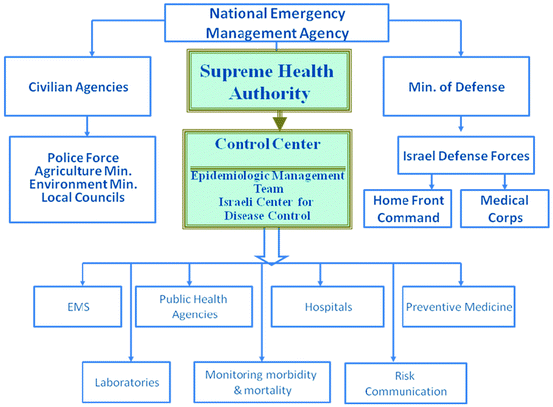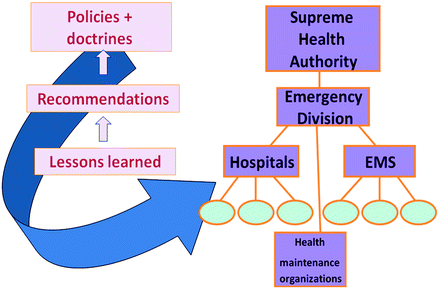Fig. 12.1
Risk assessment process in Israel
12.2.3 Classification into Families – Viral, Bacterial, Toxins, Pandemics
There are numerous agents that pose a biological threat on the public health. Developing a designated response to each type of threat can be both confusing and non-productive to the healthcare personnel. Therefore, a generic response model characterizes the preparedness to manage these potential events. Nevertheless, as there are specific differences between the agents, the preparedness is designed to suit four main families as follows [16]:
Viral agents such as viral encephalitides, viral hemorrhagic fevers, and smallpox.
Toxins such as aflatoxin, botulinum, and ricin.
Bacterial diseases such as anthrax, brucellosis, plague, Q fever, and tularemia.
Pandemic influenza resulting from antigenic shift such as H5N1 and H1N1.
12.3 Preparedness and response to health emergencies in Israel
The emergency preparedness response plan is based on a 5 C model composed of: (1) comprehensive contingency planning, (2) command of operations, (3) central control, (4) coordination and cooperation, and (5) capacity building of healthcare personnel [1–3].
12.3.1 Comprehensive Contingency Planning
The response model for all types of emergencies is based on the all-hazards approach as there are common components of emergency management regardless of the specific type of scenario [22]. Preparedness for a multi-casualty incident serves as the basis for the preparedness and needed modifications are implemented, such as personal protection gear and decontamination capabilities for toxicological or chemical events and vaccinations or anti-viral medications for a biological event. The aim is to create mechanisms for a generic universal response to the various threats.
The doctrines are developed nationally, by special committees and task forces that are nominated by the MoH. They are then disseminated to the medical organizations that adapt them into institutional standard operating procedures (SOPs), based on their resources and infrastructure. The institutional plans must be reviewed and approved by the MoH or the Home Front Command (authorized for this activity by the MoH).
Designated equipment (such as personal protective gear or life saving equipment) and pharmaceuticals (such as antibiotics for anthrax) required to treat casualties and patients that are admitted to the medical facilities during emergencies, are procured by the MoH. At times, these are produced locally by the MoH, such as the vaccines or Vaccinia Immune Globulin (VIG) for smallpox. Some of the equipment is stored in national warehouses spread across several geographic locations and the remainder is distributed to the medical facilities to ensure their immediate availability for deployment in times of need.
Relevant infrastructure, such as decontamination facilities or isolation facilities, is installed in the medical facilities by the MoH, regardless of the ownership of these institutions (governmental, Health Maintenance Organization (HMO), non-governmental organizations (NGOs), or private facilities).
12.3.2 Command of Operations
The overall responsibility for preparing and managing a bioterror event in Israel is under the jurisdiction of the Ministry of Defense. The National Emergency Management Agency (NEMA) is the highest authority that functions as the overall coordinator and directs operation of the various governmental ministries. The healthcare system is managed by the Supreme Health Authority (SHA) which is the highest authority operated by the MoH (see Fig. 12.2). It is headed by the director-general of the MoH and the other members include the director-general of the largest Health Maintenance Organization (HMO) and the Surgeon-General of the Medical Corps in the Israeli Defense Force (IDF). In the meetings of this authority, representatives participate from all relevant agencies including the three additional HMOs, the emergency medicine services, the Home Front Command, and NEMA. The SHA convenes regularly during routine times to develop operational doctrines for all healthcare institutions and to follow-up their effective implementation. During a biological event, such as the last A/H1N1 influenza pandemic, it convenes twice a day, usually utilizing teleconference channels.


Fig. 12.2
Structure for managing an event
In order to deploy the emergency response and monitor its implementation, the SHA conducts professional forums during prolonged events (conflicts or biological events) that serve as the basis for information flow and direct communication. Daily teleconferences are also conducted with directors of acute-care hospitals as well as primary care institutions including the directors of all four HMOs and health district officers.
12.3.3 Central Control of Emergency Readiness and Preparedness
Maintaining readiness to respond to emergencies requires an ongoing evaluation of preparedness. Such evaluation facilitates identification of strengths and weaknesses and encourages continuous improvement of emergency preparedness. The evaluation is based on a structured tool that includes approximately 1,000 measurable and objective parameters, amongst them 300 parameters that measure readiness for biological events. These evaluations are conducted once every 2 years in all acute-care hospitals and once every 3 years in the primary care institutions. The evaluators consist of employees from the MoH and the Home Front Command that are experts in the areas evaluated. A follow-up is conducted to ensure implementation of findings presented in the evaluation.
Ongoing capabilities of the medical institutions are monitored based on three information systems: (1) on-line admission data (ATD systems) that continually transmit information regarding utilization of hospital beds, including admittance and discharge of patients in the emergency departments, (2) web-based daily reports on critical services (such as the number of ventilated patients), and (3) a geographic information system (GIS) that enables a continuous surveillance to manage communicable diseases and bioterror events. The GIS maps the medical institutions and facilitates recognition of available medical services and monitoring spread of infectious diseases.
A crucial component of the central control is the conduct of an After Action Review (AAR) following every type of emergency, such as a mass casualty incident (MCI), a toxicological event, or the occurrence of the H1N1 influenza pandemic. The AAR is conducted in three levels; initially in the organizational level (hospital, HMO or emergency medical service); secondly in the regional level headed and chaired by the Emergency & disaster management division of the MoH and finally in the level of the Supreme Health Authority (see Fig. 12.3). A structured AAR tool is utilized to facilitate the process of identifying and learning lessons.


Fig. 12.3
Conduct of an After Action Review
An additional important component is the dictated level of surge capacity that the acute care hospitals have to maintain in order to manage an immediate response to an emergency scenario. The MoH dictates three levels of surge that each hospital is required to prepare for: (1) expansion of surge capacity for immediate MCIs at an extent of 20% of the total routine bed capacity, (2) expansion of surge capacity for prolonged emergencies such as conflicts with neighboring countries, at an extent of between 40 and 60% of routine bed capacity, and (3) expansion of surge capacity for biological events at an extent of 60% of routine bed capacity. In order to effectively prepare for these expansions, the MoH provides the hospitals with the necessary equipment and infrastructure.
12.3.4 Coordination and Cooperation Among the Various Emergency Agencies
Coordination and cooperation among the various emergency agencies is achieved by the following main components: (1) development of joint doctrines so that common terminology is utilized by the different agencies and all teams can be easily acquainted with the responsibilities and activities of interface forces, (2) joint communication channels and mechanisms installed to facilitate sharing of information and relay relevant data during emergencies, (3) joint drills and exercises that are conducted annually in which representatives from the various medical institutions such as hospitals, primary care facilities, health districts, ministerial bodies etc. participate, and (4) liaison officers who are deployed upon an occurrence of an emergency to ensure flow of information and facilitate effective utilization of resources.
12.3.5 Capacity Building
National and regional training programmes are initiated by the MoH in order to ensure knowledge and capabilities of the healthcare personnel. Advanced training materials such as video films, computerized software and training kits are produced on a national level and disseminated to the various healthcare institutions to be utilized in conducting annual training programmes. Representatives from all the healthcare agencies are trained by the MoH and then function in their institutions as “nucleus knowledge groups” in charge of training relevant personnel. The development and implementation of training programmes are evaluated by the MoH as part of the evaluations that are conducted to assess the level of emergency preparedness. Regional simulation exercises are held in which representatives from the different institutions participate. These enhance multidisciplinary communication and coordination between intra and inter sectors. A compulsory exercise programme is dictated by the Supreme Health Authority and the performance levels are measured and assessed, as well as follow-up of implementing lessons learned.
12.4 Legal Frameworks
Israel has developed a legal framework to ensure a response to emergencies [4]. Three main legal frameworks facilitate effective management of the healthcare system during times of emergency, the Public Health Ordinance (1940), the Civil Defense Law (1951), and the National Health Insurance Act (1995).
12.4.1 The Public Health Ordinance
The Public Health Ordinance was enacted when Israel was under the British mandate and was adopted by the Israeli government upon the creation of the State in 1948. This law provides the MoH with an extensive tool to respond to public health threats, focusing on communicable diseases. Under this law, the Director-General of the MoH is authorized to compel any person, healthcare employee or medical institution to take any action deemed necessary in order to prevent, mitigate or limit consequences of a biological event. Among other actions, the Director-General can direct healthcare providers to conduct house calls, supply all medical and public health services, bury the dead, detain for medical inspection travelers from infected areas, procure land or buildings to accommodate detained population, and forbid exit from infected area. These extensive authorities provide the MoH administration with powerful tools to control epidemics and pandemics.
Stay updated, free articles. Join our Telegram channel

Full access? Get Clinical Tree


